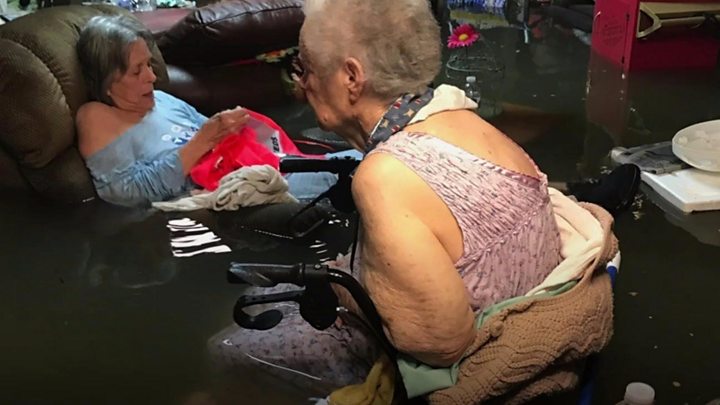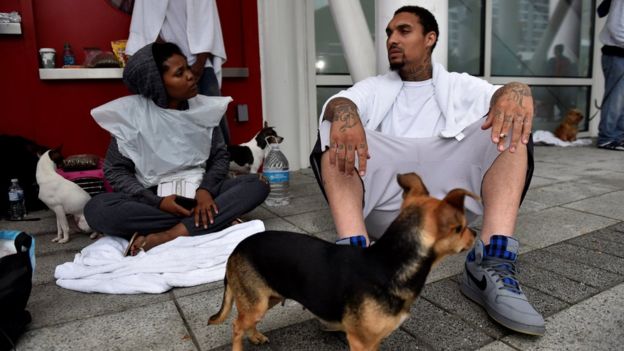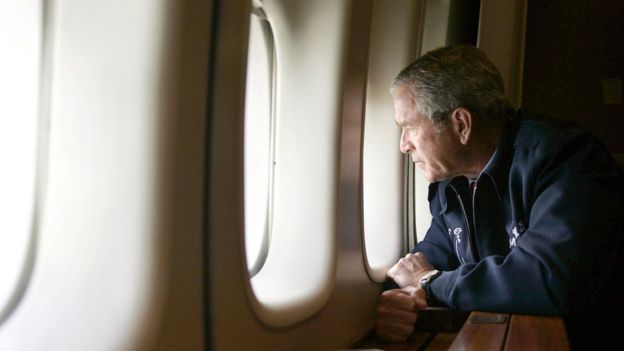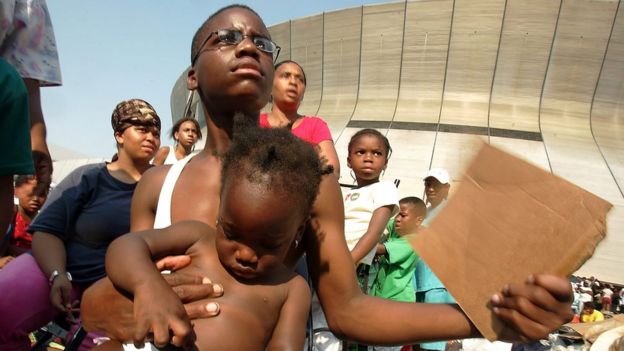Harvey v Katrina: Have New Orleans lessons been learned?
Scenes of vulnerable people in Houston trapped in rapidly rising floodwaters are evoking memories of the 2005 Hurricane Katrina disaster in which nearly 2,000 people died.
The US government response to Katrina is widely seen as an abject failure that saw poorer, mainly black residents abandoned to fend for themselves.
More than a decade later, have the lessons of Katrina been learned?
(Click here for videos and the origional article on BBC news)
No evacuation yet
New Orleans and the surrounding area were evacuated days before Katrina made landfall, with about 1 million people – nearly 80% of the population – fleeing their homes.
Those residents who could not leave on their own were to be driven out by bus, but the main route out of the city quickly became clogged.
Officials instead sent poorer residents to the city’s Superdome stadium, where 30,000 eventually gathered in deteriorating conditions.
In Houston by contrast, Mayor Sylvester Turner initially decided against evacuating Houston, a city of 2.3 million people, saying it would have caused more problems.
“If you think the situation right now is bad, you give an order to evacuate, you are creating a nightmare. Especially when it’s not planned,” he said.
The decision to evacuate Houston in 2005 – as Hurricane Rita advanced just weeks after Katrina – led to 20-hour jams and the deaths of more than 100 people, he said.
Nevertheless, residents in some of the region’s badly affected neighbourhoods have been ordered to leave.
Yet others say they are simply too poor to leave their homes.
Better shelters
In Houston, the Federal Emergencies Management Agency (Fema) said more than 30,000 people were expected to be placed in temporary shelters.
In an echo of Katrina, a Houston landmark – the George R Brown Convention Center – has been turned into a refuge for evacuees.

In New Orleans, the Superdome stadium was designated a refuge of last resort for those who could not leave the city. Photographs showed queues of mainly black residents waiting to be allowed in.
But conditions soon deteriorated – the wind blew parts of the roof off, rain came in, the field flooded and temperatures inside soared.
Officials were unable to provide enough food and water for those inside the stadium, power was cut, toilets broke and people inside reported intimidation and violence.
There was one suicide in the Superdome and some people with medical difficulties died there, reporter Dave Cohen from WWL radio said.
“It really became a place of mass suffering where people didn’t have any sense of hope,” he said.
By contrast, reporters at the George R Brown Convention Center say staff had supplies of nappies, food, water, clothes, books, games and other essentials for evacuees, many of whom were still in wet clothes. Spanish and Vietnamese translators were also on site.
Pets, banned from shelters, were being taken to animal shelters.

The Red Cross has prepared dozens of shelters, including as far away as Dallas, and San Antonio city officials are preparing to host people from Houston and other parts of the Texas coast.
Supplies and critical infrastructure
After Katrina the lack of supplies prompted residents to break into shops in search of food.
Responding to reports of looting, then Louisiana state governor Kathleen Blanco warned that security forces had M16 assault rifles that were “locked and loaded”.
“These troops know how to shoot and kill, and they are more than willing to do so if necessary, and I expect they will,” she said.
In one incident, two people were killed and four others injured when police opened fire on two families foraging for food. More than a decade later, the officers pleaded guilty to conspiracy, obstruction of justice and civil rights charges.
 Image copyrightREUTERS
Image copyrightREUTERSIn Houston, Fema says it is providing more than a million meals, more than a million litres of water, 20,000 tarpaulins and 70 generators.
The agency says it has deployed 1,800 staff. Some 30 aircraft and 500 high-water vehicles have been deployed in the rescue effort. Army engineers are helping to restore power and critical infrastructure.
They have also begun releasing water from two dams that protect Houston city centre over fears they could burst.
During Katrina some of the levees designed to protect the city from flooding failed because they had been poorly maintained.
Meanwhile the federal government is bolstering security forces with homeland security personnel and defence department assets.
Trump to visit, unlike Bush
The White House says President Trump will visit Texas on Tuesday to survey the damage.
Former President George W Bush was accused of insensitivity for failing to visit New Orleans in Katrina’s immediate aftermath. He instead released a photo of himself looking out of a plane window at the damage.
 Image copyrightAFP/GETTY
Image copyrightAFP/GETTYHowever Reuters news agency reported that the large number of resources needed to facilitate a presidential visit meant that most administrations avoid visiting at the height of natural disasters so as not to divert resources away from rescue efforts.
During his campaign, Mr Trump toured the scene of flooding in Louisiana and criticised President Obama for going on holiday during the storm.
Permanent refugees
A million people left the New Orleans region during Katrina – many did not return. More than a decade on, the city’s official population of 390,000 is 50,000 down on pre-Katrina levels.
About 250,000 people moved to Houston during Katrina and between 40,000 and 100,000 are estimated to have stayed there permanently.
They are now facing catastrophic flooding for the second time.
 Image copyrightGETTY IMAGES
Image copyrightGETTY IMAGES“I’m a realist now after Katrina. Anything can happen,” Kate Quarrella Beard toldNola.com after evacuating from her new home in Dickinson.
“It was basically like watching everything over again, and there’s nothing I can do. I can’t cry anymore,” she added.
Asked whether Harvey could become Houston’s Katrina, State Governor Greg Abbott said it was “not the time to second-guess the decisions that were made”, the Associated Press news agency reported.
“Because of the effort that we’ve been able to put together, I think and believe we will be very successful,” Mr Abbott said.


